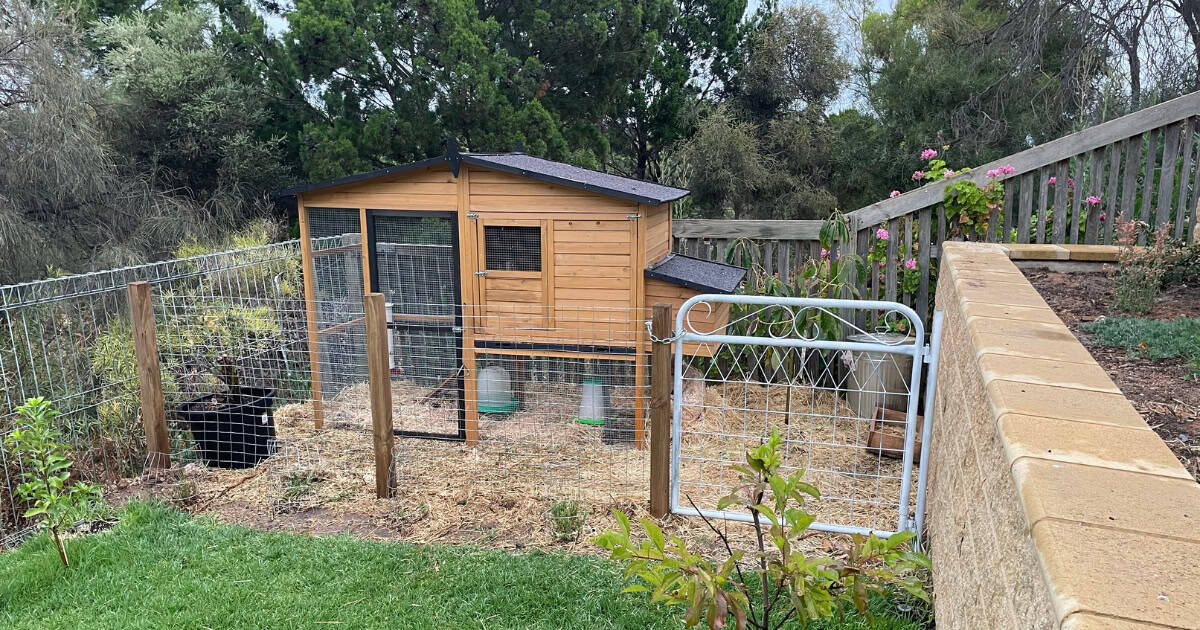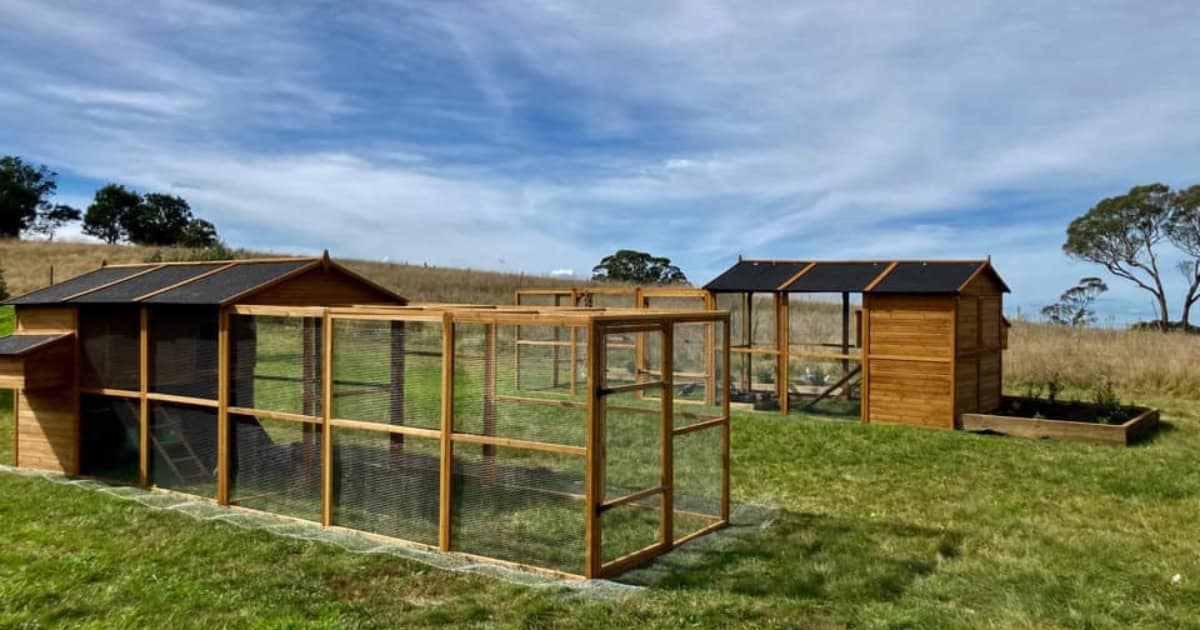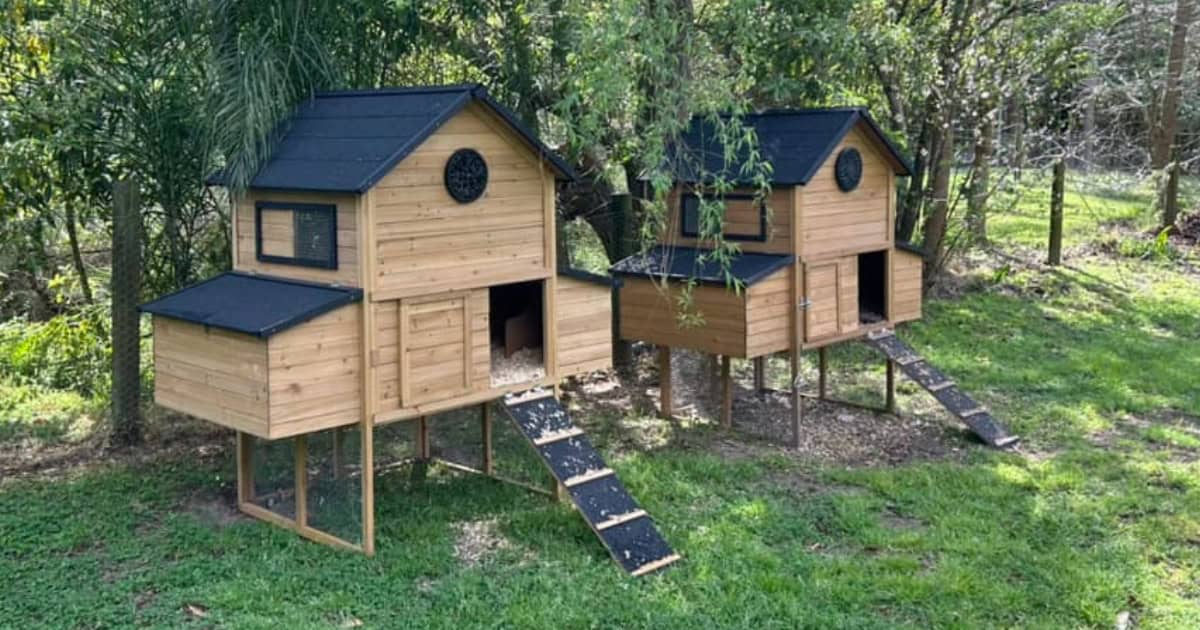Chickens
Essential Tips for Designing Your Chicken Coop
If you’re considering raising chickens, let us set you up for success and guide you in designing your chicken coop. We’ll start with choosing a spot that keeps your flock happy and healthy.
Next, we will explore the crucial aspect of chicken coop sizing as well as the importance of ventilation.
We’ll shed some light on why sunshine is important for laying hens before discussing materials that will withstand the Aussie weather. And because foxes are sneaky, we’ll sort out how to keep those predators away from your flock.
Stick around as we guide you through everything you need to know about designing your chicken coop.
- Understanding the Basics of Chicken Coop Design
- Getting Started With Designing Your Chicken Coop
- Essential Features Of Your Chicken Coop
- Selecting the Right Location for Your Chicken Coop
- Sizing Your Chicken Coop Correctly
- Ensuring Adequate Ventilation When Designing Your Chicken Coop
- Incorporating Natural Light into Your Chicken Coop Design
- Choosing Materials for Your Chicken Coop
- Planning for Predator Protection
- Toni’s Wrap
Understanding the Basics of Chicken Coop Design
If you’re planning to keep chooks in your backyard, designing a proper chicken coop is crucial to accommodate the natural behaviours of your chickens and simplify maintenance.
The ideal coop design includes ample room for each chicken to roam. You don’t want them feeling cramped. Plus, happy chickens are healthy ones—they’ll reward you with more eggs if they’ve got adequate coop space.
Your coop should be secure against predators—foxes love an easy snack. A sturdy structure with secure latches keeps those cheeky critters out and gives you peace of mind.
Getting Started With Designing Your Chicken Coop
When it comes to designing your chicken coop, putting a personal touch on your coop design is both rewarding and fun.
If you enjoy a hands-on project, consider building your coop using new materials such as timber and hardware cloth for a clean and customised feel, or get inventive with recycled materials for an eco-friendly option.
If the DIY route seems too adventurous, flat pack chicken coops are available in Australia from online retailers like Somerzby and Coops and Cages. They come with everything pre-cut and pre-drilled, making assembly a breeze.

Essential Features Of Your Chicken Coop
A well-designed chicken coop should incorporate several essential features to ensure the health, safety, and productivity of the chickens. Here are some key features:
Adequate Size: Provide enough space for the number of chickens you have. It is generally recommended to provide 2-3 square feet per chicken inside the coop and 8-10 square feet per chicken in their outdoor run space.
Ventilation: Ensure proper ventilation to maintain good air quality inside the coop and help prevent moisture buildup. Vents and windows should be positioned to allow fresh air circulation without drafts.
Roosts: Chickens naturally prefer to roost off the ground, install roosting bars at an elevated position to allow chickens to perch comfortably at night. Ensure there is adequate space for the amount of chickens you plan to house.
Nesting Boxes: Position nesting boxes in an area easy to access for egg collecting. Place them in a quiet, dimly lit corner to provide privacy and security for laying hens.
Easy Cleaning Access: Design the coop with easy access for cleaning. Removable trays or floors that can be cleaned regularly help maintain a healthy environment.
Secure Doors and Latches: Ensure that doors and latches are secure to protect the chickens from predators. Consider adding locks or additional security measures.
Predator Protection: Use materials and construction techniques that deter predators and keep your chickens safe. This includes burying wire mesh around the coop to prevent digging and using sturdy materials for the coop frame.
Natural Light: Incorporate windows or translucent panels to allow natural light into the coop. Adequate light helps regulate the chickens’ circadian rhythms which assists with egg-laying.
Weather Protection: Provide insulation and weatherproofing to protect chickens from the elements and extreme temperatures. Adequate ventilation should be balanced with protection from drafts.
Feeder and Waterer: Install secure feeders and waterers to ensure a constant supply of food and water for the chickens. These should be easily accessible and kept clean.
Accessibility: It’s a good idea to design the coop to be easily accessible for daily tasks such as egg collection, feeding, and cleaning. Consider human convenience in design with easily accessible nest boxes and large coop doors.
Dirt Floor: A dirt floor or designated dust boxes or dirt bath areas in a coop’s outdoor space is essential. This promotes natural dust bathing behaviour, ensuring feather cleanliness, oil regulation, and effective parasite control, contributing to overall chicken health and happiness.
By incorporating these features, you can create a comfortable and safe environment for your chickens, promoting their well-being and productivity.

Selecting the Right Location for Your Chicken Coop
When you’re planning where to set up your chook house, think about sun and shade. You want a spot that catches the morning light but stays cool in the afternoon heat. Make sure it’s high and dry too, because good drainage keeps things healthy.
Predators are crafty, so placing your coop near the house can deter them due to human activity. But keep it far enough away from neighbours to avoid any issues over noise or smells.
Consider convenience as well; having water access nearby will save time during daily care routines.
Sizing Your Chicken Coop Correctly
When it comes to your chooks’ home, size does matter. A coop that’s too small can lead to stress, pecking, and health issues for your chooks. But a huge coop isn’t necessary either; you just need enough space for them to move around comfortably.
Each chicken needs at least 0.37 square metres of coop floor area – this is the bare minimum. If you’ve got five chickens, they’ll need about two square metres of space in their coop so they’re not on top of each other. Remember though, more room is always better if you have the backyard space.
Let’s not forget the outdoor roaming area – around eight to ten times the indoor space will give your chickens plenty of fresh air and exercise during the day while keeping them safe from any pesky predators.
Ensuring Adequate Ventilation When Designing Your Chicken Coop
Good ventilation is vital for your chooks’ health, and it’s more than just letting fresh air in. It’s about maintaining a flow that removes moisture, ammonia, and carbon dioxide from the coop. To do this effectively, consider installing vents or windows near the roof where hot air naturally rises to escape.
You’ll want these openings to be adjustable; you can open them wider during Australia’s scorching summers but keep them smaller when the cooler months roll around. Just remember: draft-free does not mean airtight—you need some airflow without creating cold drafts on roosting birds.

Incorporating Natural Light into Your Chicken Coop Design
Chickens thrive on sunlight; it spurs egg-laying and keeps them healthy. When designing your coop, think of windows as a gateway to wellbeing for your flock. Position these strategically to catch the sun yet avoid overheating in summer.
Avoid placing windows directly opposite each other; this can cause drafts. East-facing windows capture morning light, vital for stimulating hens’ laying cycles.
It is also recommended to use materials that won’t just stand up against the elements but will allow ample light penetration without compromising security or insulation—think sturdy wire mesh combined with clear polycarbonate panels.
Choosing Materials for Your Chicken Coop
When selecting materials for your chicken coop, think about durability and ease of cleaning. A popular choice is untreated timber such as Chinese Fir wood, which is naturally resistant to rotting. Remember to avoid treated wood that could harm your chickens.
Opting for galvanised wire in your chicken coop plans offers exceptional durability and corrosion resistance, ensuring a sturdy barrier against predators.
Bonded asphalt sheeting offers excellent weather resistance and insulation to safeguard your feathered companions from the elements while ensuring a long-lasting and low-maintenance shelter.
Planning for Predator Protection
Enhance your chicken coop’s security by adding a dual-layered defence – bury wire mesh beneath and extend it outward from the base to prevent predators from digging in. Boost protection further by lining the perimeter with sturdy pavers.
Aerial threats like hawks also fancy a chicken dinner. Deter them with sturdy netting or chicken wire over your outdoor runs. Remember, locking up tight at dusk keeps nocturnal predators away as many predators strike after dark when chickens are most vulnerable.
Lastly, don’t forget about snakes and rodents who might slip through small gaps looking for eggs or chicks. Fine mesh across windows and any openings will help keep these smaller critters out.
Toni’s Wrap
As we wrap up our exploration of designing your chicken coop, we’ve gained valuable insights into the significance of materials, size and features. These considerations are crucial, whether you choose to create your coop from scratch or opt for the convenience of a flat-pack solution.
May these lessons guide you in crafting a secure and comfortable haven for your feathered friends, regardless of your chosen approach.




